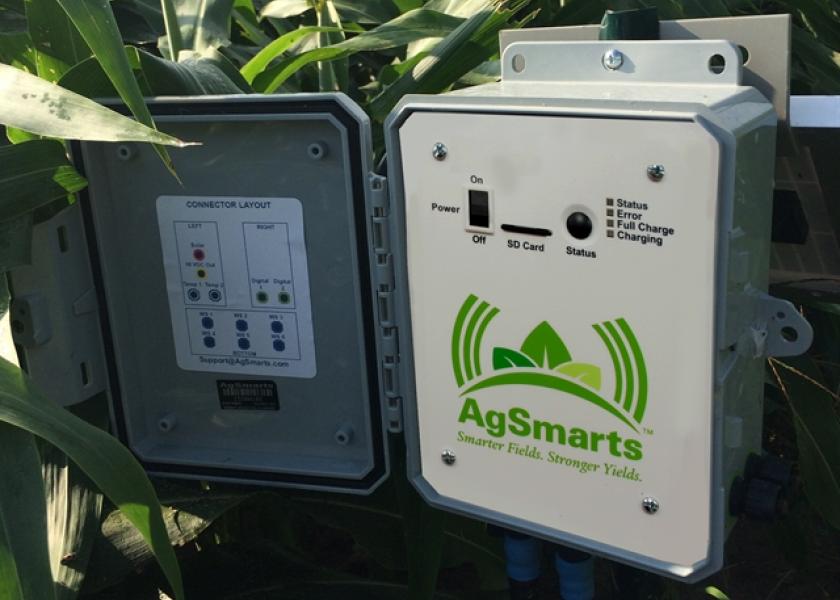Irrigation recipe for smarter fields, bigger yields

Answer irrigation questions wrong and cripple a crop.
Guesswork and irrigation are long-time farming partners, but it's a happy-in-hell marriage for many producers. When to turn on the spigot? How much water to deliver? Every farm soaks and dries in isolation because one field's irrigation recipe is another's death sentence. Every year, ill-timed irrigation pulls off a double steal across many operations. Parched by a trickle or choked by a torrent, crops raised with poor water choices pile on extra fuel costs and are robbed of precious yield.
AgSmarts, a company at the vanguard of precision agriculture, is relieving the irrigation timing burden through a one-stop, catch-all sensor network. Think sensor stations across an operation acting as crop sentinels. Machines with onboard intelligence recognizing crop, growth stage, and soil profile. In turn, the one-stop stations offer moisture-sensing technology, predictive analytics, and farm equipment automation to build a framework toward a major jump in data-driven agriculture.
AgSmarts makes remote sensing stations,
not sensors. The stations are set up for plug-and-play mode for the top sensors in the ag industry. Eleven sensors can be plugged in simultaneously and the stations are configured with AgSmarts' mobile app over Bluetooth. The stations' data is delivered by the hour to a free web portal. Multiple stations can be placed around an operation, and the units communicate over a wireless mesh network and reach the Cloud with one connection point. Simply, a producer pays for one cell modem and data plan for the entire network of stations. If cellular isn't the preferred method of connecting to the cloud due to cost or availability, AgSmarts' stations can be configured with a Wi-Fi module which eliminates the need for data plans. This flexibility of telemetry (cellular, Wi-Fi, Bluetooth, mesh) allows producers a wide array of data access options and a means of dramatically lowering the cost of environmental sensing.
Water management, optimization of irrigation triggers, soil temperatures, planting dates, accumulated degree days, heat units, wind speed, rainfall, pump flows, water level detection and much more can be gathered remotely at one source. "Farmers want to know when, how much and why," says Brett Norman, AgSmarts CEO. "That's what the station and data allow. Quickly log in and visually see what a crops needs. Alerts and emails also tell when the soil is drying down. There is a tremendous amount of money to be saved by cutting water and boosting yields."
Norman emphasizes four key benefits provided by the stations to AgSmarts customers. First, soil moisture at variant depths is vital: When to pull the water trigger and how much to deliver? Second, ground-truthing rain gauge sensors. Third, precise temperature data (both ambient and soil) for planting dates or field-level GDU calculations. Fourth, wind speed and direction readings to help prevent drift or preserve data for liability disputes.
Even advanced irrigators are still forced to use a lot of guesswork. Simultaneously, they are squeezed by profit margins and pressures from regulatory bodies. "AgSmarts provides industrial control not only for irrigation, but also for nutrient delivery and fertigation. True industrial controls to allow farmers to embed intelligence at the smallest field level," Norman describes.
Tunica, Miss., producer Buddy Allen grows a mix of grain sorghum, cotton, corn, and wheat on his Delta operation, but his greatest acreage emphasis is on rice and soybeans. Allen has 12 AgSmarts stations spread across his farm and uses a smartphone, tablet and laptop to read incoming data, depending on whether he's in the field, truck or office. "We use the AgSmarts equipment to monitor soil moisture to schedule irrigation based on crop water needs according to growth stage. Additionally, we keep track of flow meter readings," Allen says.
Beyond data readings and alerts, the AgSmarts platform is piloting actionable data recommendations in 2016 trials. "We have got a universal, agnostic sensor approach, and this gets farmers excited. Although we make them more rugged, we don't manufacture the sensor itself and therefore have no legacy products to push," Norman says. "We also have strong ties to conservation. We're tying economic and environmental benefits together."
Smarter fields lead to stronger yields, and Norman believes AgSmarts has engineered the most effective means to automate and optimize existing irrigation systems. "True automation is often a misused term, but that's what we're talking about," he adds. "Irrigation struggles never end and the same questions remain for farmers: When to put out water and how much? Those are the precise questions answered by AgSmarts."







